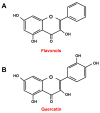Quercetin and Thyroid
- PMID: 39456456
- PMCID: PMC11505551
- DOI: 10.3390/antiox13101202
Quercetin and Thyroid
Abstract
Quercetin is the most abundant flavonoid present in fruits and vegetables. For its antiproliferative, antiviral, anti-inflammatory and antioxidants activities, it is an active ingredient of several herbal remedies and is available as a nutraceutical. Experimental studies performed in vitro have demonstrated that quercetin inhibits growth and function in normal thyroid cells and may act as a thyroid disruptor. These effects have also been confirmed in vivo using rodent models. Some studies have reported the ability of quercetin to interfere with the metabolism of thyroid hormones, since it inhibits the 5'-deiodinase type 1 (D1) activity in the thyroid, as well as in the liver. Besides the effects on normal thyroid cells, several experiments performed in vitro have shown a potential therapeutic role of quercetin in thyroid cancer. Indeed, quercetin inhibits the growth, the adhesion and the migration of thyroid cancer cells, and it also has redifferentiation properties in some thyroid cancer cell lines. In conclusion, these data suggest that, although its effects can be of benefit in hyperthyroidism and thyroid cancer, caution is required in the use of high doses of quercetin due to its anti-thyroid properties. Further in vivo studies are certainly needed to confirm these hypotheses.
Keywords: FRTL-5 cells; endocrine disruptors; flavonoids; quercetin; thyroid.
Conflict of interest statement
The authors declare no conflicts of interest.
Figures



References
-
- Montané X., Kowalczyk O., Reig-Vano B., Bajek A., Roszkowski K., Tomczyk R., Pawliszak W., Giamberini M., Mocek-Płóciniak A., Tylkowski B. Current Perspectives of the Applications of Polyphenols and Flavonoids in Cancer Therapy. Molecules. 2020;25:3342. doi: 10.3390/molecules25153342. - DOI - PMC - PubMed
LinkOut - more resources
Full Text Sources

